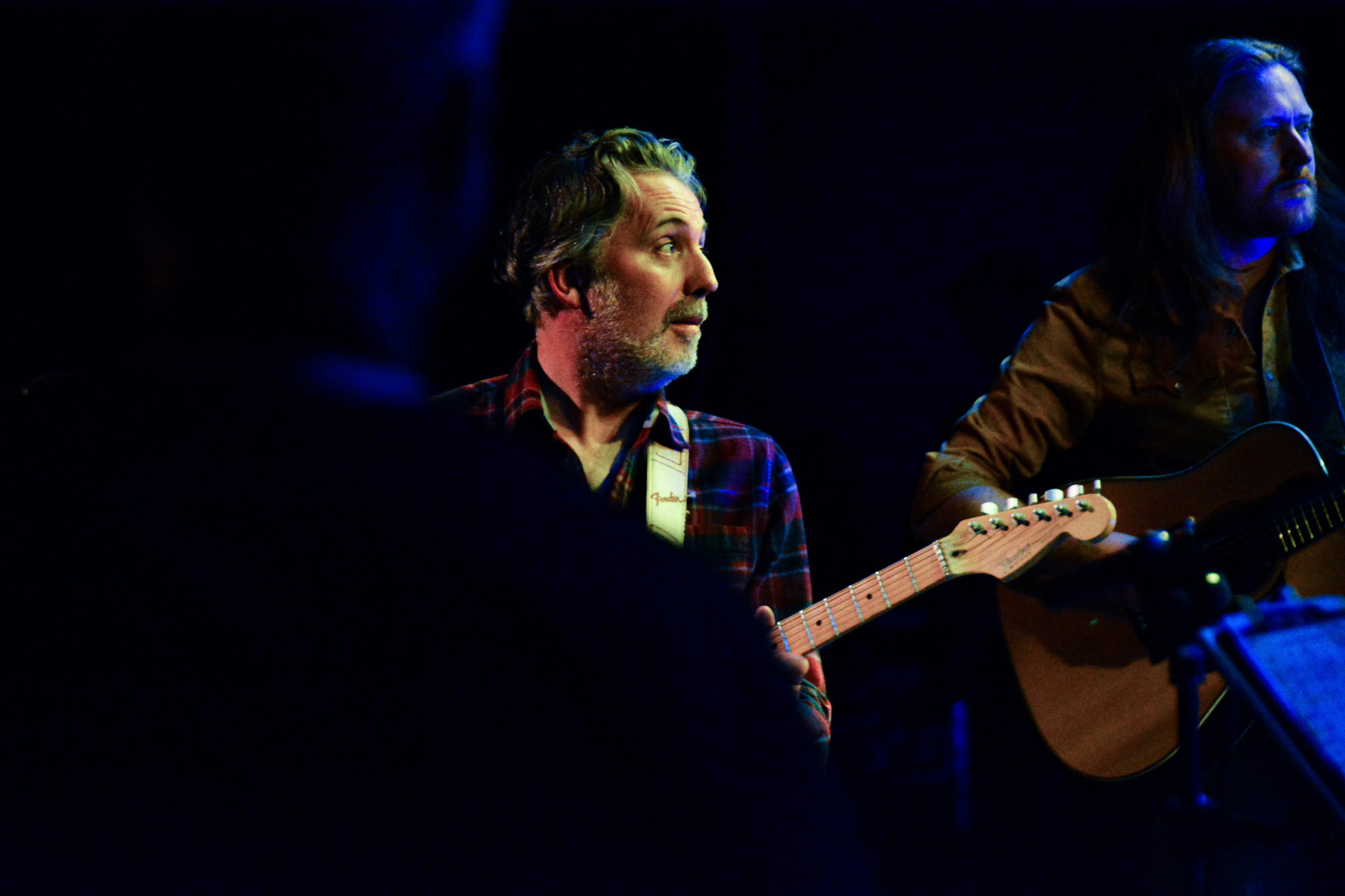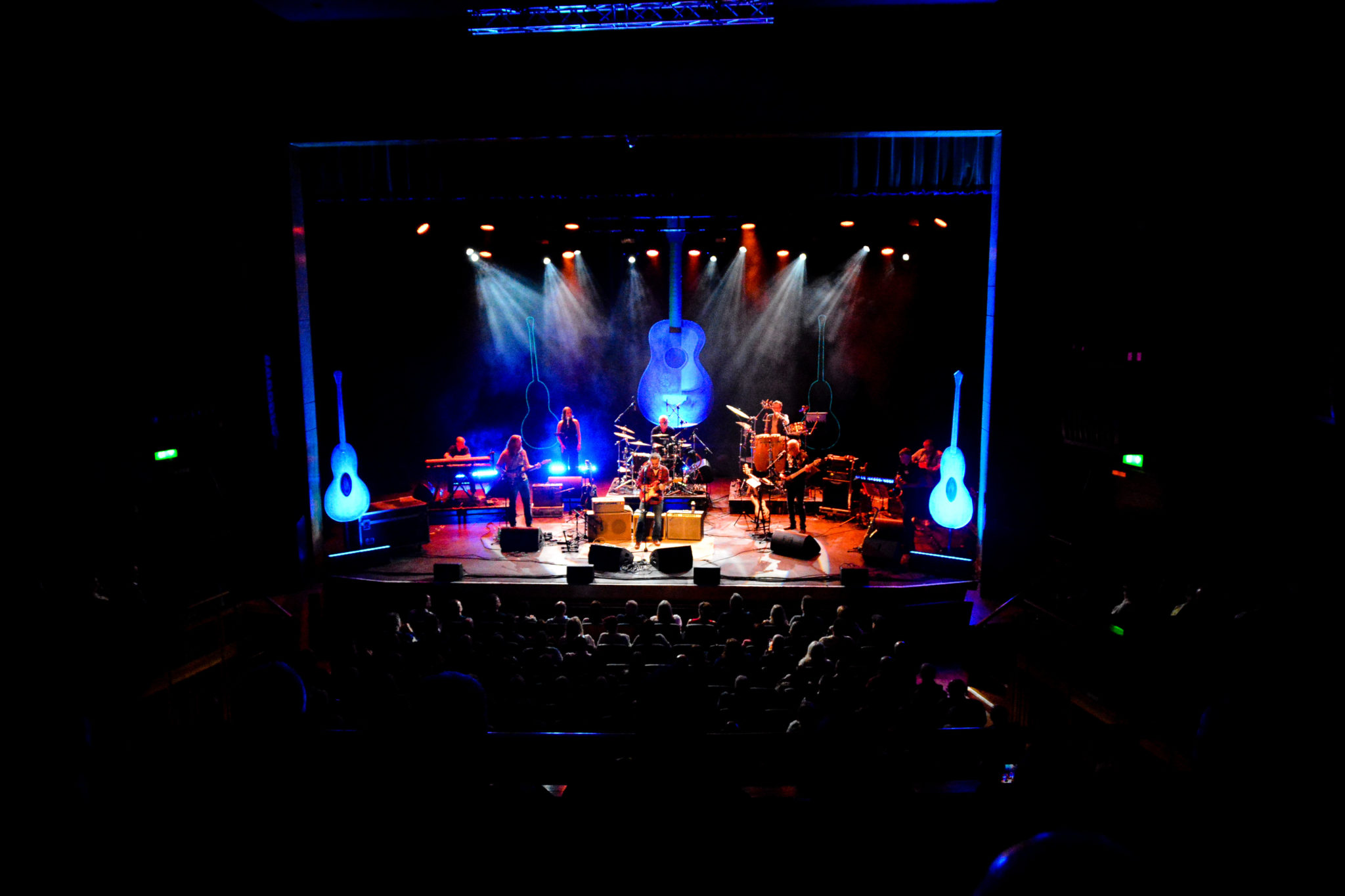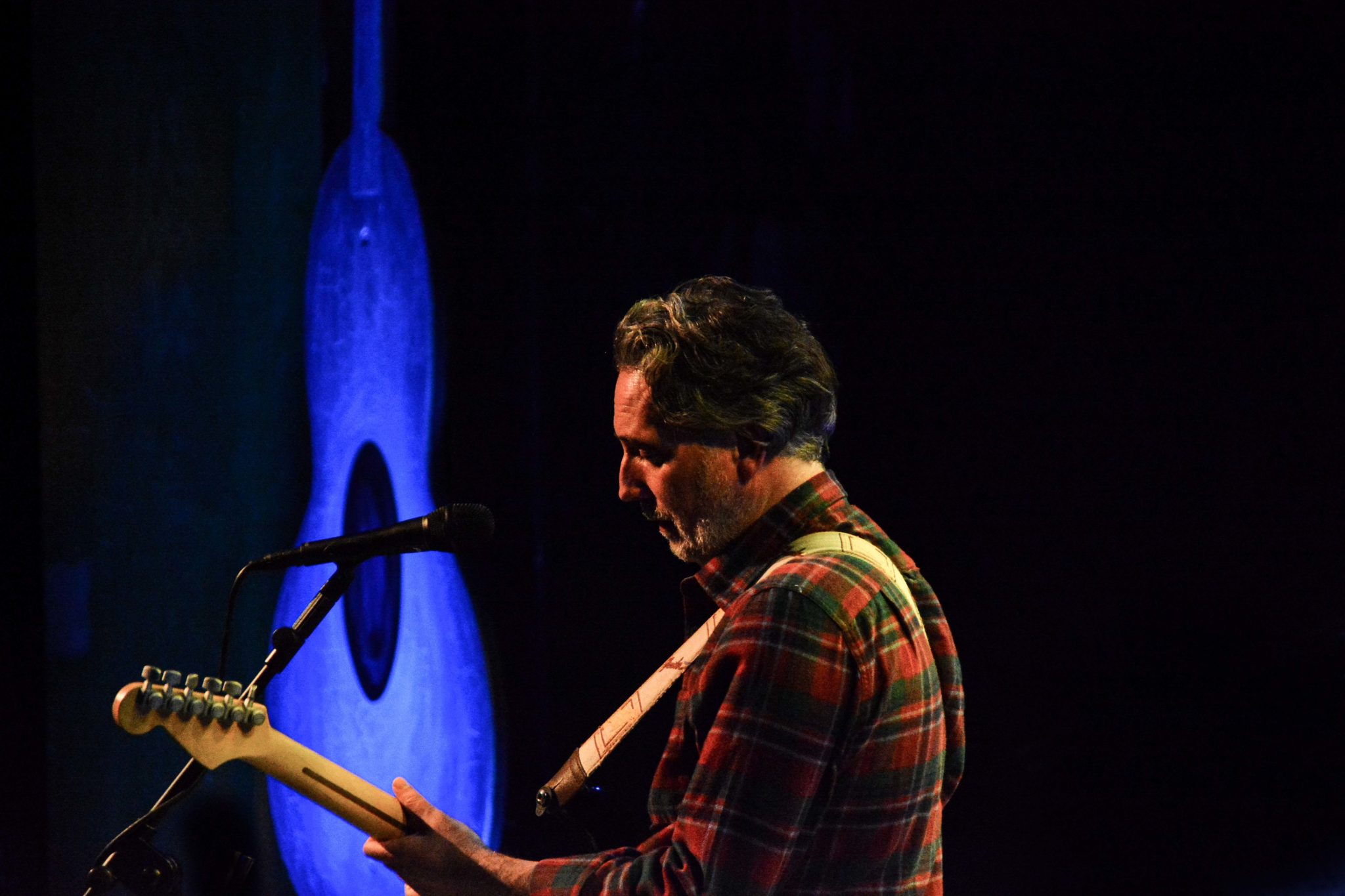- Music
- 29 May 25
Live Report: Rea-magined – Paul Casey plays the music of Chris Rea at Derry's Millennium Forum

Paul Casey brought his special Chris Rea tribute show to the Millennium Forum, as part of the City of Derry Jazz Festival, this month.
In 1993, a teenage Paul Casey met Chris Rea backstage after a gig at the King’s Hall, Belfast. When Casey was leaving, the only way out was via the stage. On the way, he paused to stand on the exact spot where his musical hero had just wowed the sold out venue. The stage was being dismantled; flight cases were rolling out, lights were being lowered. But Rea’s famous amps were still in place. Looking out into the empty hall, he knew he wanted to be a part of this. But not just this live music thing… Rea’s music was Casey’s Bible; he wanted to be part of this Rea thing.
That was the teenage vision. For five years, he studied Rea’s every note. One demo tape later, Paul Casey found himself in Rea’s London studio, recording together. They became close friends. Before long, Paul joined his mentor’s live band, and was the special guest on his tours across Europe.
Evidently, there’s nobody on the planet more qualified than Paul Casey to curate and perform a night of Chris Rea’s music. He’s got the chops, for sure. But he’s also got the instinct of his long-time mentor, and therefore how to suitably honour his musical legacy.
And so, it was fitting that the City of Derry Jazz Festival – in its 24th year – set the stage for Casey to debut Rea-magined. Curated and performed by the protégé, backed by his stellar band, the show was programmed to bring a close to the festivities for the 100,000 festival-goers.
Inside the Millennium Forum, European accents rise above the chatter; German, Danish, Dutch, Norwegian, French – and English! – speakers queue at the merch stand. Northern Irish fans are here in force as well, but there’s an abundance of supporters who have flown into the Walled City for the gig.

The band launches into 'Nothing’s Happening By The Sea' from the Water Sign album. The mood is set as Casey’s atmospheric slide guitar sits atop synthy 80s keys. Just like Rea, Casey is in an open E tuning with compressor on, delivering a clean crisp amp sound. Next up is 'Stainsby Girls '– an ode to Rea’s wife who was a pupil at Middlesbrough’s Stainsby Secondary Modern School – complete with soulful sax solo.
Casey’s guitar looks and sounds just like Rea’s legendary 'Pinky' Fender Strat. Could it be? On stage, he explains that local artist Gerry Moran painstakingly recreated a doppelgänger from Casey’s own guitar, right down to painting and printing the intricate stickers from Rea’s Strat, and creating the same wear marks.
'I Can Hear Your Heartbeat' – a huge hit in Europe, particularly Ireland and Germany – proved a real crowd pleaser. The band brings it way down for 'Windy Town', as Casey switches to normal tuning, and Dan Miller steps forward on the outro. The band interplay throughout is effortless, atop the rock-solid foundation of Liam Bradley on drums and Nicky Scott on bass.
Then Casey and the band unleash the potency of Rea’s songwriting in 'Josephine', featuring a funky piano solo by Johnny McCullough. “Always have a dictaphone with you”, Rea once told Casey (in the days before mobile phones). It was into a dictaphone that Rea recorded the opening line of 'Josephine', while staring out a hotel window on a rainy day in Germany ("Rain on my window, but I'm thinking of you"). He told Casey that if he didn't capture it like that it would've been gone forever. He still has the recording.

Rea recently spoke highly of his apprentice’s guitar-playing in a rare interview with Hot Press: “His first demos were absolutely amazing. It was an eerie feeling for me because it was as if I’d played it. It was so accurate.” The same could surely be said for Casey’s execution of Rea’s live slide solo on 'Working On It', which proved a thoroughly bluesy affair. He brings everything back down for 'Nothing To Fear', from the God’s Great Banana Skin album, conjuring up a haunting Middle Eastern-sounding tone on the slide.
Casey’s slide guitar playing shapes the night. He has spoken of always hearing Rea’s slide guitar as an extension of Rea’s voice. The same could be said of Casey himself on 'Nothing To Fear'; the slide takes over the moment he stops singing. He expresses everything when sliding into the note – or working the bottle neck for more vibrato, or pushing it harder to capture something altogether darker. The slide unlocks Casey’s Fender to deliver emotion and expression in spades.
Backed by Dan Miller’s flawless playing, Casey’s guitar continues to shine; he closes out 'Auberge' with impressive runs before coming right down for the bluesy licks of 'Looking For The Summer'. The band transitions effortlessly into 'Fool (If You Think It’s Over)', Rea’s breakthrough song in the US, which was later covered by Elkie Brooks. Drums and percussion set up the groove before Casey’s intro lifts the crowd, followed by solos from Dan Miller on guitar, Johnny McCullough on keys and Paul Cutliffe on brass.

In a classic Rea transition, Fool’s percussion outro segways beautifully into 'Bombolini'. This gem was rarely played in the latter part of Chris’ touring career. It proves a fan favourite on the night; its glorious guitar riff is perfectly played. Rea’s riffs seem like they were always there; they stay in your head, and you wonder if they’d ever not been there.
The band quickly turns their hands to 'Ace Of Hearts', gelling skilfully on the funky, uplifting coda. Next up is Steel River, the opening track of the Shamrock Diaries album. It’s a song borne of working class Northern England, evoking the coming and going of boats at the Port of Middlesbrough. Casey recalls watching jazz fusion band Stuff’s legendary 1976 Live at Montreux Jazz Festival concert, at length, in the studio with Rea. That influence can be heard throughout Shamrock Diaries, which has been Casey’s go-to album since its release in 1985. The band steps up to the mark, as John McCullough summons the spirit of Stuff’s Richard Tee in a huge gospel-driven piano outro, before launching into the celebrated 'On The Beach' with its iconic riff that’s been covered the world over. The group delivers it in Rea’s true live style, complete with reggae outro.
Casey’s singular and intricate knowledge of Rea’s sonic world can be heard in the arrangement of each song on the night. His curation shines on 'It’s All Gone' as he takes on a live version that Chris played at Montreux Jazz Festival in the '80s. He unveils the cinematic guitar quality of the song, and its uncannily melodic nature. On slide guitar, Rea’s solos are so much more than a series of improvised notes – they stick in your head, because they’re inherently melodic – and Casey pulls them off with aplomb. He takes the lead as Johnny McCullough’s Fender Rhodes line develops, before Dan Miller takes on the celebrated Robert Awahi guitar riff that sets the scene for yet more world-class solos.

Casey plays with exquisite reverence for his mentor, and it's all set against an original Rea stage. Giant-sized guitar backdrops make up the set design. Huge recreations of Chris’ own paintings, that were part of his own tour production 20 years ago, hang from the Forum fly loft. And that’s not all that came out of storage for Rea-magined. Flight cases in the wings are emblazoned with “CHRIS REA / GTRS / AMPS”. And yes, as Casey notes from the stage, he’s using Chris’ 1962 Fender Tremolux, and his Fender Reverb Pro, the very same ones that Chris played live throughout his career.
The classic hits come thick and fast. Every one of Rea chart-toppers, and more, are aired – die hard Rea fans and casual supporters alike are absorbed throughout. 'The Road To Hell, Part II', Rea’s biggest chart hit other than 'Driving Home For Christmas', is introduced with drone and slide guitar before sliding into the iconic guitar sound that Casey captures to a tee. It's quickly followed by the finale, 'Let’s Dance', with its overdriven bluesy guitar riff. The crowd are on their feet – and appropriately! – dancing.
The band returns for an encore in 'Looking For A Rainbow', Rea’s concert-closer on The Road To Hell album tour. It's an epic-sounding number; at the end Casey trades solos with Dan Miller, before finishing with a spine-tingling slide guitar masterclass. He effortlessly glides to the end of the fretboard, backed all the while by Rea’s fabled amps. As that unmistakable sound soars into the rooftops, one can’t help but think about that night more than 30 years ago when he stood on the stage beside those very same amps. You went on to join the world you dreamt of, Paul Casey. Now you’ve written the next chapter, honouring your friend’s musical legacy with style and precision. Rea-magined, indeed!
See the full Rea-magined photo gallery here.
For upcoming dates see reamagined.com

RELATED

- Pics & Vids
- 29 May 25









